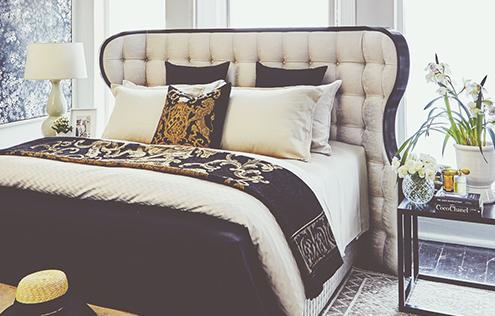HOW TO CHOOSE YOUR BED?
The golden rules of good bedding
Studies show that good quality bedding increases the sleep continuity: sleep comes faster and there are fewer nocturnal awakenings, meaning one hour more of sleep every night. More than half of people suffering from chronic lower back pain usually find an improvement of their symptoms when sleeping on a new mattress.
It is important also to ensure that the bedding in which you will invest is well ventilated. Each night, the sleeper eliminates more than a quarter litre of sweat through skin pores and it is necessary to evacuate this perspiration. Special attention must be given to ventilating your mattress if you are asthmatic.

On average, a mattress and bed base provide optimal support for eight to ten years of daily use.

The important thing is to think in terms of long-term investment. Remember that a quality mattress significantly influences sleep quality.

When lying down, your spine should rest completely. If you live as a couple, both of you should try. A good mattress will support the body perfectly at all levels.
The bed base and the mattress are equally important. They are the duo of good sleep. These two elements must be designed to suit each other; it is recommended to replace them at the same time, and opt for a bed base suited to the type of mattress chosen and comfort desired.
In reality, the choice of bedding is alchemy between the needs of the body and a personal feeling about one technology or another.
If we had to give one overall piece of advice, we would say that the key is to choose bedding that combines a soft reception and deep firmness. On bedding that is too hard, the spine arches upwards, while on a bed that is too soft, it droops.


When choosing a mattress, there are some golden rules to go by. First of all, the ratio between height and body mass defines the weight per square centimetre: the higher this is, the more the mattress must be firm.
Then, if you sleep on your side, it is recommended you choose a softer multi-zone mattress to reduce pressure on the shoulders and the pelvis thus allowing better blood flow with the resulting cellular regeneration.
If you sleep on your back and you have a pronounced dorsal curvature, it is best to choose a mattress that will allow your pelvis to sink enough so that the lumbar support provided is sufficient.
Age is yet another component. Young people deal with a firmer support better. Over the years, the search for comfort develops and we begin to appreciate a softer layer.
This is the "Rhumaless" system used to visualise on screen, in real time, the pressure points exerted on your body in your preferred resting position. Here science and experience work hand in hand to help you identify the most suitable mattress.
In the illustration opposite, we can easily see the most suitable bedding and the one that must be avoided. With Elite mattresses, acceptable pressure zones are represented by light shades. In the "Other brands" example, the illustration shows an unsuitable pressure zone represented by dark shades.
Elite mattresses simply offer better sleep than other brands. Because we make your mattress, we can also recommend the one that will help you sleep better.